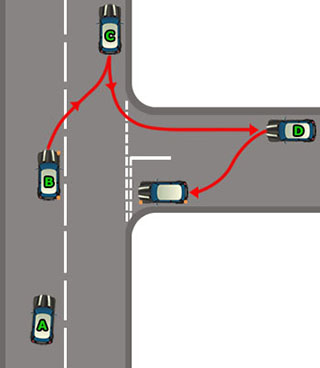Reversing Into A Side Road
Start the manoeuvre two to three car lengths away from the road you intend to turn into.

At key points stop & check your mirrors, blind spots & general surroundings making sure it is safe to continue the manoeuvre.



Your end point is a good distance up the side road or if on your test, continue until the examiner tells you to stop. The examiner will want to see that you can reverse in a straight line, parallel to the kerb, for at least two car lengths.

Remember:
- your vehicles wheels must not mount the curb or cross the centre road markings. If they do you will fail your practical driving test.
On Your Driving Test, The Examiner Will Expect You To Reverse Round A Corner:
- Safely, correctly and smoothly while keeping your vehicle under control.
- While keeping reasonably close to the curb.
- Without mounting or hitting the curb.
- Without swinging out too wide.
- Regularly check traffic and road conditions.
- Look out for traffic and pedestrians.
- Stop in a safe position.
Hitting the kerb will not result in automatic failure – not as long as the examiner concludes you did so due to a minor error of judgment and sees that you took proper action to correct the error.
If the examiner concludes you mounted the kerb because you had no idea what you were doing or had lost control of the car, you will fail.
Reversing into a side road can be the safest and most convenient way to turn round. However, great caution is needed when performing this manoeuvre.
Remember when reversing into a side road not only are you reversing against traffic emerging from the junction but as you reverse into the side road the front of your car will swing out into the road. Because of this, you must continually observe the environment – what’s happening to the front, back and sides.
Seatbelt – you are legally permitted to remove your seat belt when reversing. If you feel doing so will allow you to get a better view behind, then remove your seat belt. However, you MUST put it back on before moving forward – even if you are only correcting your endpoint position. If you don’t put the seat belt back on, you will fail the driving test.
Reversing Into A Side Road on The Right

When you want to turn your car around but there are no convenient places on left, you will need to
A to B
Select the turning where you can perform the manoeuvre in a safe, legal, and convenient manner. Use the MSM routine and take up a position as if you were turning right. If there are other road users around you, you may need to delay indicating right, as otherwise, they may think you are turning right.
B to C
Wait for any oncoming traffic at the point of turn and look into the road for any obstructions that would make your manoeuvre unsafe. Steer over to the right and stop a foot or so away from the kerb and about two or three car lengths past the corner. Remove your seatbelt if this helps you get a better view behind and, if you need to, open your window so you can get a better look at the kerb.
C to D
Put the car into reverse gear. Remember, you are manoeuvring on the wrong side of the road so take extra care. Keep looking round, and be prepared to react to other road users. When it is safe to do so, move slowly back. You should look over your left shoulder as you approach the corner, but look round to the right regularly to check your position and judge when to turn.
Just before turning, look all around again, remembering that the front of your car will swing out as you steer right. Look over your shoulder as you steer and follow the kerb. How much steering you need will depend on how sharp the corner is.
When you have turned the corner, look over your left shoulder again, as this will help you assess if your car is straight enough in the road. When your car is straight, turn the steering wheel to the left to keep the car straight as you continue to move. Check your distance from the kerb using the nearside door mirror. Drive far enough up the side road so that you have room to get back onto the left side of the road to approach the junction properly.
Reversing Into A Side Road on The Right
If the manoeuvre is going to affect other road users, remember they have priority. Always be prepared to stop and let them make the decision to continue forward or to stop and wait for you to finish the manoeuvre.
When reversing into the side road, if you encounter any pedestrians, cycles, or any other road users who want to cross the road, you must stop and let them cross.
